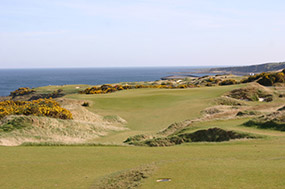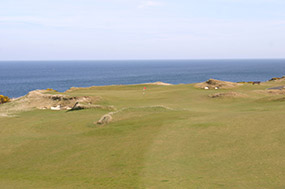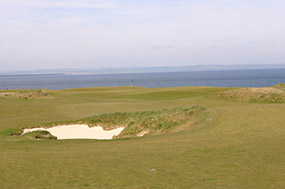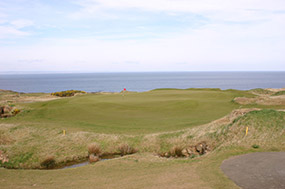One of the most disappointing courses in modern times, the Castle Course at St Andrews was designed by David McLay Kidd and built for the St Andrews Links trust to ease demand on popular town links like The Old and The New.
The seventh course to open in St Andrews, the Castle occupies a dramatic clifftop property a mile or so southeast of the main part of town. This former farming ground was converted into a full blown Whistling Straits-inspired quasi-links by Kidd and his team in 2008, with an incredible amount of earthworks and shaping done to create the various features, landforms and playing corridors. The routing itself is very scenic, with a number of superb outlooks from the course across the sea to the town proper. The closing stretch in particular provides beautiful views and finishes with a couple of holes that literally play across and along the St Andrews cliffs.
The disappointment of the Castle Course lies mostly in the unnecessarily excessive shaping of the internal playing areas, as well as the unduly severe nature of many of the green complexes. Like on a number of Kidd courses across the globe, several greens here were softened right after opening and one could argue there were still many more that needed work to make playable. The problem with a lot of Kidd’s greens, is that they are built firstly to reject approach shots played from bad angles, rather than to accept shots hit from the right areas. There are a number here that are virtually impossible for the average golfer to hit and hold in regulation, and sadly some occupy the most breathtaking parts of the course.
The best example of where Kidd went wrong with his greens is at the par four 6th, a tumbling dogleg with a perched green that has an incredible view of the old town, but is essentially inaccessible for anyone who can’t drive 300 plus yards down to the bottom fairway shelf. There are countless other examples of pushed up and steeply angled green complexes that seem only to exist to torment the poorer player. The likes of the 2nd, 7th, 15th and 17th should have all been tremendous holes but aren’t.
Another annoyance many have with the Castle Course, is the tufts of fescue dotted throughout many of the fairways. These usually occupy small humps and mounds and are placed randomly inside the holes to inject the sense of chance into proceedings. The concept of golfers essentially hacking out of rough in the middle of the fairway does seem a little ill-conceived. Worse is the fact that unlike the older links in Scotland, playing corridors here are rarely set between the dunes and ridges, and instead it seems that all the heavy undulation is contained within the golf holes rather than on the periphery. This design philosophy certainly ensured that the holes at Castle were dramatic, though at times they become a little severe on the average golfer.
Given the strength of the Fife Kingdom for golf, and the fact that countless examples of modern-day excess exist for Kidd and his design team to study and learn from, the fact this layout is so demanding and so unfriendly for the green fee paying public golfer is a big surprise. The views alone will ensure that demand remains reasonably high in the short-term at the Castle Course, but the golf here lacks fun and charm and there is no doubt that most visitors would rather be playing Old or New or even Kingbarns further down the road. Given the tremendous potential this project had, it simply needn’t have been that way.

 this course also has exceptional:
this course also has exceptional:



